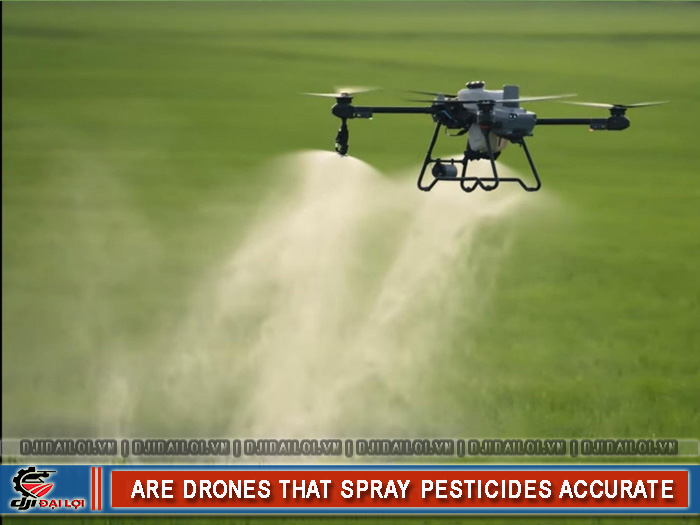
Drone-based spraying represents a major leap forward in Vietnam’s smart farming evolution. Instead of relying on manual labor, UAVs allow for precise, uniform, and controlled pesticide application. Since 2020, the introduction of drones such as the DJI Agras, XAG P-Series, and Yamaha FAZER R has accelerated the mechanization trend, delivering higher productivity and significantly reducing labor costs.
Remote-controlled spraying drones not only reduce time and labor but also enhance crop protection effectiveness. GPS-assisted control enables centimeter-level accuracy, minimizing chemical loss and reducing direct exposure to toxic substances. This is a crucial step toward safe and sustainable agricultural modernization in Vietnam.
The Vietnamese market is currently dominated by three brands: DJI, XAG, and Yamaha.
All aim to maximize spraying productivity and minimize operating costs.
One key factor in evaluating drone accuracy is the spraying and positioning system. Modern drones integrate GPS RTK with positioning errors of only a few centimeters, ensuring flight path precision. High-pressure nozzles and flow sensors control spray volume precisely, preventing overlaps or missed areas.
Uniform coverage depends on propeller design and airflow turbulence during flight. Models like the DJI T40 and XAG P100 use multi-directional radar to detect obstacles within a 360° range and automatically adjust flight altitude to maintain consistent coverage. This is critical for efficient spraying in complex field conditions.
Flight speed and spraying height directly affect pesticide adhesion to leaves. Flying too fast causes dispersion, while too low leads to oversaturation. The optimal speed is 4–6 m/s with a height of 2.5–3 m, achieving over 90% spray accuracy.
A modern remote-controlled spraying drone can cover 15–30 hectares per day - 40–60 times faster than manual spraying. Productivity varies by model, battery capacity, and terrain. For example, the DJI Agras T50 can spray up to 16 hectares per hour using its dual-pressure spraying system and optimized auto-flight paths.
Most drones use high-capacity lithium batteries (20,000–30,000 mAh), offering 15–20 minutes of flight per charge. Quick-swap batteries enable continuous operation. Automated liquid control also reduces pesticide use by 20–25% compared to manual methods.
|
Brand |
Coverage (ha/hour) |
Engine Type |
Key Advantages |
|---|---|---|---|
|
DJI Agras T50 |
16 |
Electric |
High accuracy, easy maintenance |
|
XAG P100 |
14 |
Electric |
360° sensors, excellent obstacle avoidance |
|
Yamaha FAZER R |
18 |
Gasoline |
Continuous operation, ideal for large farms |
Real-world statistics show that spraying drones can increase productivity up to 50 times compared to manual spraying while reducing costs by 30% and minimizing operator exposure by 90%.
An agricultural drone can replace 10–15 manual workers, saving an average of 5–7 million VND per hectare per crop. Precision spraying reduces pesticide use by 25% while maintaining pest control efficiency.
Operators can control the drone hundreds of meters away from the spraying area, avoiding inhalation or direct contact with chemicals. Drones also include emergency shutdown systems and error alerts for enhanced safety.
Accurate spraying ensures even pesticide distribution, preventing leaf burn or overuse. According to the Vietnam Crop Research Institute, drone spraying increased rice yields by an average of 8–12% compared to manual methods, proving the effectiveness of automated spraying technology.
Strong winds above 5 m/s, rain, or sloped terrain reduce spray accuracy. For tall crops such as corn or coffee, drones must fly higher to ensure coverage. Early morning or late afternoon spraying provides optimal adhesion.
Operators must understand flight mapping, speed, and spray flow. DJI drones allow customized spray maps and data storage for consistent and repeatable operations.
Weak batteries or dirty nozzles reduce efficiency. Manufacturers recommend cleaning nozzles every 20 hours of operation and replacing batteries after 500 charge cycles to maintain stable productivity.
Most farmers report that drones save time, reduce fatigue, and significantly boost productivity. In Đồng Tháp province, a cooperative shared that using the DJI Agras T40 reduced labor costs by one-third in a single crop season.
Users should prioritize drones with at least a 20L tank, quick-swap batteries, and obstacle avoidance sensors. For small farms, models like the DJI T25 or XAG P30 are ideal.
The most important factor is training a skilled operating team and maintaining the equipment regularly. Large farms should manage centralized spraying data to avoid overlap or missed plots.
Choosing the right model ensures maximum return on investment.
By 2030, Vietnam aims to expand drone-based spraying with AI integration, meteorological sensors, and big data systems for precision agriculture, supporting sustainable green farming.
With their precision spraying, labor savings, and optimized chemical use, remote-controlled spraying drones are proving indispensable in modern agriculture. Thanks to fast ROI and long-term benefits, they are a worthy investment for farms of all sizes.
Currently, no pilot license is required, but operators must undergo basic drone control training and comply with agricultural flight safety regulations.
Electric drones are suited for small-scale farms, offering easy maintenance and eco-friendliness, while gasoline-powered models deliver higher capacity for farms over 30 hectares.
Yes, but always follow safe mixing procedures and clean the tank after each use to prevent chemical reactions that reduce effectiveness.
High-end models such as the DJI T40 and XAG P100 feature obstacle sensors and navigation lights, allowing safe night spraying under low-light conditions.
With proper maintenance, agricultural drones typically last 4–6 years, and batteries should be replaced after around 500 charge cycles to maintain consistent performance.